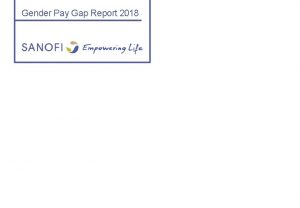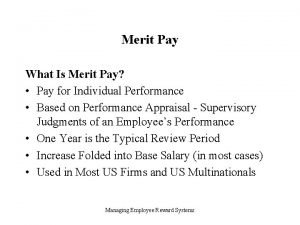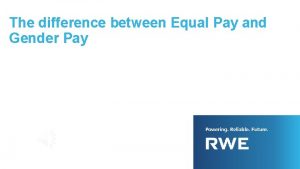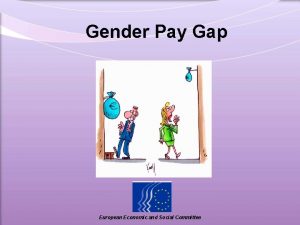Developing indicators for the gender pay gap and

















- Slides: 17

Developing indicators for the gender pay gap and segregation Ruth Emerek FREIA (Feminist REsearch Centre In Aalborg), Aalborg University, Denmark EGGE (EU commissions Expert Group on Gender and Employment)

Indicators and Gender mainstreaming Indicators are important in the EU-gender mainstreaming process • “Gender mainstreaming involves not restricting efforts to promote equality to the implementation of specific measures to help women, but mobilising all general policies and measures specifically for the purpose of achieving equality by actively and openly taking into account at the planning stage their possible effects on the respective situation of men and women (gender perspective). This means systematically examining measures and policies and taking into account such possible effect when defining and implementing them” (European Commission 1996). • “Gender mainstreaming may be described as “the (re)organisation improvement, development and evaluation of policy processes, so that a gender equality perspective is incorporated in all policies, at all levels and at all stages by the actors normally involved in policy making” (Council of Europe 1998: 12). Ruth Emerek Lancaster June 2008 2

Gender mainstreaming and equality Gender equality should gain from gender mainstreaming • Gender mainstreaming is a gender equality strategy • Gender mainstreaming is not a replacement for direct equal opportunities policy but an addition to it. • Gender mainstreaming appears to be very difficult to practice for the authorities • Gender mainstreaming, however, is important in a gender equality perspective • An important task: to assess the gender mainstreaming processes and make sure that it is a real equality process and not just a process in ‘documentations’ and in ‘figures’! Ruth Emerek Lancaster June 2008 3

Four steps of gender mainstreaming 1. Getting organized. • implementation and organization, and building awareness and ownership. 2. Learning about gender differences. • to describe gender inequality with regard to participation, resources, norms and values and rights, and to evaluate trends without policy intervention. 3. Assessing the policy impact. • to analyse the potential gender impact of the policy with reference to participation, resources, norms, values and rights. 4. Redesigning policy. • to identify ways in which the policy could be redesigned to promote gender equality. (Gender mainstreaming of employment policies, A comparative review of thirty European countries, 2007) Ruth Emerek Lancaster June 2008 4

Step 2. Learning about gender differences This means that we have to • have empirical knowledge of gender inequality – not only to figures but also the facts behind figures • know how to measure inequality – or to develop new ways of measuring equality. Concentrate here on pay and segregation – • As in Denmark the authorities do not mention pay gap, without saying due to gender segregation, in the same sentence. I will question the traditional acceptance of this relation Ruth Emerek Lancaster June 2008 5

Pay • How do we measure the pay gap? • The average difference between men’s and women’s pay in relation to men’s average pay • Why not the average difference i relation to women’s average pay? • Which is more transparent and shows how many percent women’s pay on average should be raised to reach the level of men’s pay. • (a pay gap of 25% corresponds to an average pay raise for women of 33% to the same level as for men) Ruth Emerek Lancaster June 2008 6

Pay Ruth Emerek Lancaster June 2008 7

Pay The pay gap is given in unadjusted form! This means that we have to adjust this pay gap to find the ‘real’ pay gap! What are we adjusting for? Acceptable factors: • Education (measured how? - by length or by area of education? ) • Seniority (measured how? – by years in the job at the labour market) Other acceptable factors? – • Segregation – when adjusted for (and the finer the occupational categorisation the better) – the factor with the highest degree of explanation! Why not adjust for the difference between the highest and lowest income percentile when comparing countries? Ruth Emerek Lancaster June 2008 8

Segregation is normally measured by the use of indices. • IP-index is used for monitoring segregation in the European employment strategy, for both occupational and sectoral segregation. • The IP-index can, as the other indices, be interpreted as the proportion of the workforce (persons in employment) which would have to change jobs in order to remove segregation. The greater the equality in the distribution over occupations for women and men, the less the segregation. • The IP-index will, however, increase for an increasing female share of employment up until the female share is fifty percent. A change in the IPindex may therefore be due to a change in the proportion of women in employment. • Persons outside employment are not taken into account! Ruth Emerek Lancaster June 2008 9

Ruth Emerek Lancaster June 2008 10

Ruth Emerek Lancaster June 2008 11

Methodological problems in measuring segregation 1. the indices may hide changes pulling in different directions; evidence of no change in the index does not indicate stagnation in the pattern of segregation – and vice versa. 2. the indices are dependent on the occupational classification system. (traditional male occupations in manufacturing industries are specified in detail, while female occupations are given in very broad categories). 3. the indices are dependent on the degree of categorisation – the better (that is the smaller) the categories – the higher the measure of segregation. The index of segregation does not only measure the segregation – but also level of the categorisation. 4. who should be included? – part-timers or full-timers only (do we measure segregation of persons or jobs? ) 5. should unpaid work be included? – Should unemployment? 6. the convergence of indices of segregation between the countries of Europe may in fact indicate a convergence in patterns of segregation or it may be a coincidence hiding very different realities in the labour markets. Ruth Emerek Lancaster June 2008 12

Recommendations on segregation indicators In the short run • indices are retained but the trends are interpreted through use of decomposition techniques - particularly for comparisons between different societies. • more awareness that segregation levels are being compared across very different entities, as the scale of women’s employment, as well as the structure of the labour markets. • attention should be paid to the adequacy of the occupational classification systems. • segregation indices need to be combined with other types of indicators. • an analysis of flows in the gender composition of occupations could provide a useful complementary measure, as shown in the next slide for Denmark. In the long run: • New and appropriate tools for indicating vertical segregation need to be developed Ruth Emerek Lancaster June 2008 13

Desegregation – or de-masculinisation? Ruth Emerek Lancaster June 2008 14

Two standpoints 1. 2. gender segregation is an indication of real gender differences, related to discrimination of women in the male-dominated labour market and causes gender wage differences. gender segregation is not the central problem, the wage gap could and should be removed by other means than by creating a gender homogeneous labour market. In my opinion: • Gender segregation is not an acceptable excuse for unequal pay – it is simply an attempt to explain away the relatively lower pay in part of the public sector – where real wage-negotiation (and strike) is difficult due to the nature of the work (nurses, midwifes, etc. ) Ruth Emerek Lancaster June 2008 15

The end Thank you for listening Ruth Emerek Lancaster June 2008 16

IP-segregation index Where: F Fi N Ni Ruth Emerek the total number of females in employment, the number of females in occupation i the total number in employment and the total number in occupation i. Lancaster June 2008 17
 Slidetodoc.com
Slidetodoc.com Gender pay gap lösungsansätze
Gender pay gap lösungsansätze Strategic gender needs and practical gender needs
Strategic gender needs and practical gender needs Designing pay levels
Designing pay levels Graduated commission examples
Graduated commission examples Contoh gender analysis pathway (gap)
Contoh gender analysis pathway (gap) How much did wanda pay in taxes this pay period?
How much did wanda pay in taxes this pay period? Merit pay vs incentive pay
Merit pay vs incentive pay Pay gap
Pay gap Ohang yordamida bog'langan qo'shma gaplar
Ohang yordamida bog'langan qo'shma gaplar A_______ bridges the specification gap between two pls.
A_______ bridges the specification gap between two pls. Fspos
Fspos Typiska drag för en novell
Typiska drag för en novell Nationell inriktning för artificiell intelligens
Nationell inriktning för artificiell intelligens Returpilarna
Returpilarna Shingelfrisyren
Shingelfrisyren En lathund för arbete med kontinuitetshantering
En lathund för arbete med kontinuitetshantering Personalliggare bygg undantag
Personalliggare bygg undantag

































